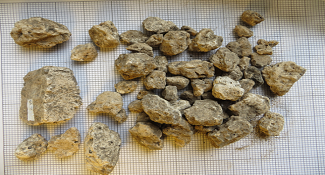Published on 01 Mar 2017 | Topics: #localhistory
In 2013 the Captain Cook Society, in conjunction with the Great Ayton History Society, applied for a small grant from the National Heritage Lottery Fund to investigate if a building had existed on the site near Aireyholme Farm and whether anything could be found linking the site to the Cook family.
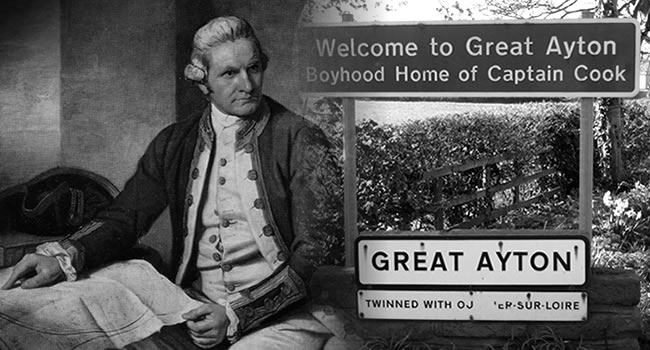
Introduction
Captain James Cook was born in Marton in 1728, however in 1736 he moved with his parents to live in Great Ayton. His father, James Cook senior, was employed by Thomas Skottowe at Aireyholme Farm as a hind or herdsman to assist the tenant farmer. In 1744, aged 16, James Cook moved to Staithes to work as a shop keeper’s boy. The lure of the sea took hold of him and he moved to Whitby. The rest, as they say, is history.
In 1755 James Cook senior retired and he and his wife moved to a new house on the outskirts of Great Ayton. This house was dismantled in 1933 and rebuilt in Fitzroy Gardens, Melbourne Australia. An obelisk made out of rock quarried at Point Hicks, Australia, now marks the spot where this house once stood.
There is however an oral tradition in Great Ayton that the Cook family lived in a dwelling due west of the main Aireyholme farm buildings when James was a boy. A 1930s’ photograph of William Martin, the then tenant farmer at Aireyholme, shows him standing at the edge of a vegetable plot. Written on the back of the photograph are the words “William Martin standing on the site of Captain Cook’s Childhood home”.
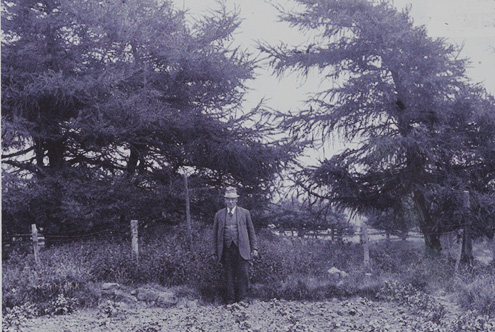
Photograph of William Martin standing in his vegetable plot in the 1930's
On studying the photograph it soon became apparent where it had been taken, however the presence of mature Larch trees suggested that the site might not be where a dwelling could have been built. Using two different sources, the History Society was able to confirm the size of the trees indicates that they were planted in the mid 1800’s, well after James Cook left the village.
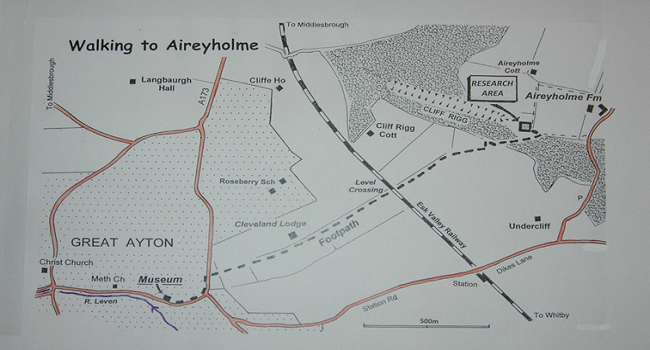
Site of the excavation
In 2013 the Captain Cook Society, in conjunction with the Great Ayton History Society, applied for a small grant from the National Heritage Lottery Fund to investigate if a building had existed on the site and whether anything could be found linking the site to the Cook family. The Lottery Fund awarded the project £9,000 in July 2014, with the History Society and the Captain Cook Society each contributing £500 to the work.
The project was in five parts:
1) Off-site research to find any supporting evidence for the existence of the cottage:
Various members of the History Society searched through local information about James Cook. This involved visiting the Cook Birthplace Museum in Marton, the North Yorkshire County Records Office in Northallerton, going to Wakefield to look over drawings (done by George Cuit in the late 1780’s) of the areas where James Cook grew up, the Cook Memorial Museum in Whitby and finally trying to identify Cook’s contemporaries at school. Unfortunately no new information was uncovered.
2) On-site exploration to identify possible indications of a building:
This was the bulk of the work and was started in April 2015 under the guidance of Kev Cale, a professional Community Archaeologist. As the site was on National Trust property we submitted a Written Scheme of Evaluation document which the National Trust approved. The Project team would like to thank the NT for their approval to work on the site.
In an attempt to narrow down where the possible location of where a building had been, Jon Kenny from the York Archaeological Trust carried out a geophysical survey of the site. The results of this work identified a couple of locations that could have been foundations for walls.
In early May 2015 the on-site excavation began with labour supplied by members of the Great Ayton History Society and other interested members of the community. Two trenches were painstakingly dug using archaeological trowels. Each trench measured 1 metre by 2 metres at the locations that the geophysical work suggested were the most likely areas for foundations. Various items were found in both trenches, including broken roof tiles, broken handmade bricks, fragments of pottery and two shaped flints. However there were no signs of foundations and importantly there were no signs of mortar which suggested that the items we had found had been dumped and that the trenches we had excavated were not on the site of a building.
The project still had a couple of days left in the budget for Kev’s time and so it was decided to dig a third trench. Kev looked at the site and identified a flat section of ground which had signs of limestone scattered around which could have been remnants of mortar. On this basis a third trench, 1 metre by 3 metres, was dug. Material similar to that found in the other two trenches was uncovered, however the team came across large quantities of mortar, a large number of rocks randomly scattered throughout the trench plus, at the top of the trench, a number of cobble stones placed uniformly as if making a floor. Unfortunately we had run out of funds and although there was evidence that there was more to uncover, we had to call a stop to the excavation, at least for 2015.
The members of the Great Ayton History Society were keen to continue with the work; however the Captain Cook Society did not want to remain involved. After some discussion, the History Society decided to self-fund another excavation in 2016, more of that later.
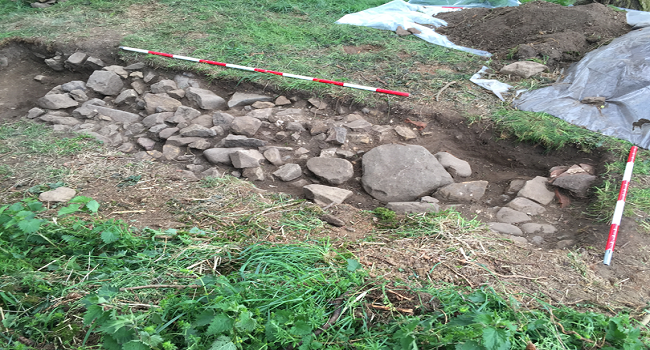
View of the third trench (above)
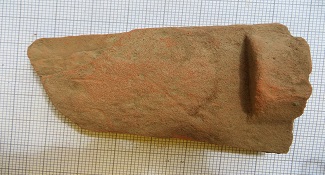
Roof tile fragment
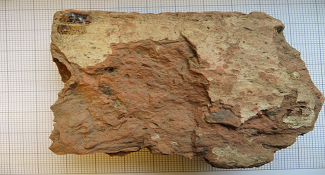
Broken Hand made brick
Clumps of mortar
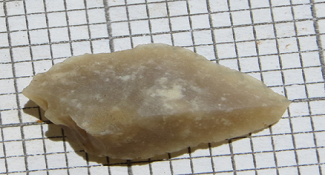
Shaped flint
3) Production of a leaflet to cover a walk from the Cook Schoolroom Museum to the possible site of Cook’s childhood home:
The leaflet has been produced and printed. It starts and ends at the Cook Schoolroom Museum. The leaflet suggests various places to stop on the route up to the site and gives some details of points of interest such as Cleveland Lodge, the railway and the old sand quarry.
4) Install an Interpretive Panel on the site of the excavation giving outline details of the area and its links to James Cook:
A panel has been produced and located on the site of the dig. It outlines what the site looked like in Cook’s time plus how it has changed over time.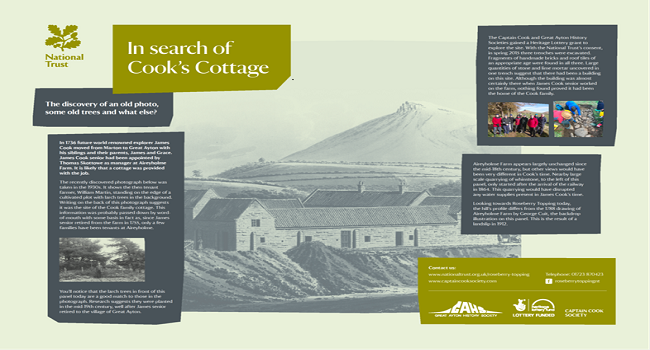
A copy of the interpretive panel. The background is a reproduction of one of George Cuit’s 1780s drawings, with Aireyholme Farm in the foreground and Roseberry Topping in the background.
5) Repair and conservation of public footpaths that connect Great Ayton to Aireyholme Farm, where the Cook family might have lived:
This aspect of the project has not been completed as permission from the Landowner to work on the path has been denied.
Having completed these 5 phases, the Heritage Lottery funded element of the project came to an end, however in May 2016 a second phase of the work, funded by the Great Ayton History Society, started.
The partner of one of the members of the History Society worked for the Ordnance Survey and she offered to undertake an OS survey of the site. Again this didn’t identify anything new.
The third trench was then opened up and extended. This work uncovered the outline of a building with internal dimensions of approximately 3 metres by 3.5 metres. It had a complete cobbled floor, with the exception of a couple of holes that could have been where wooden poles were used to section off the inside of the building. There was also a cobbled drainage channel across the floor and a hearth in a corner of the building. Again we found broken tiles, broken bricks and significant quantities of mortar, however we also came across part of a bone comb, fragments of pottery, a piece of a glass bottle and a small fragment of window glass.
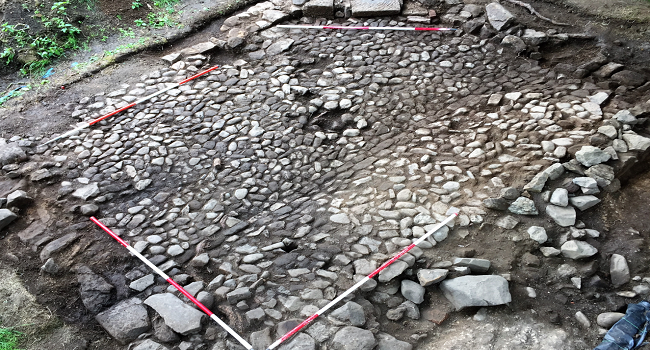
View of the uncovered building
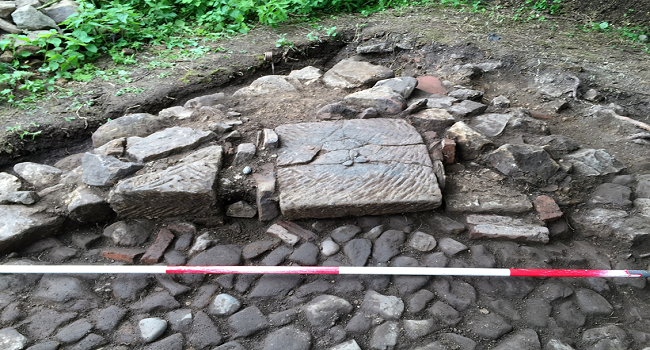
Hearth showing cracks caused by exposure to a fire
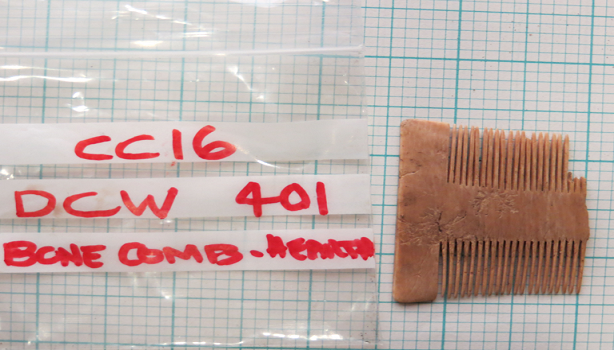
Bone Comb
We did seek expert advice on the age and likely use of the building. It would seem that the construction indicates that it was built in the late- 17th / early- 18th century, (i.e. before James Cook was born.) The drainage channel in the cobbled floor would suggest that the building had at some time been used to keep animals, however the presence of a hearth, plus the domestic items found in the building, would indicate that at some stage it had been used for human habitation.
Unfortunately we did not find anything that could indicate that James Cook lived in the building. However, in view of the original photograph suggesting the location of the Cook family cottage, together with our findings of a cobbled floor and hearth, we can but dream that James Cook once lived there. Who knows perhaps his father demolished the building to use the bricks and roof tiles for his retirement home in Great Ayton, hence it doesn’t appear in any of the Cuit drawings.
Article kindly written for Visit Great Ayton by John Rowlands of Great Ayton History Society (All images courtesy of Great Ayton History Society).

